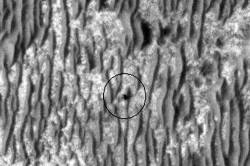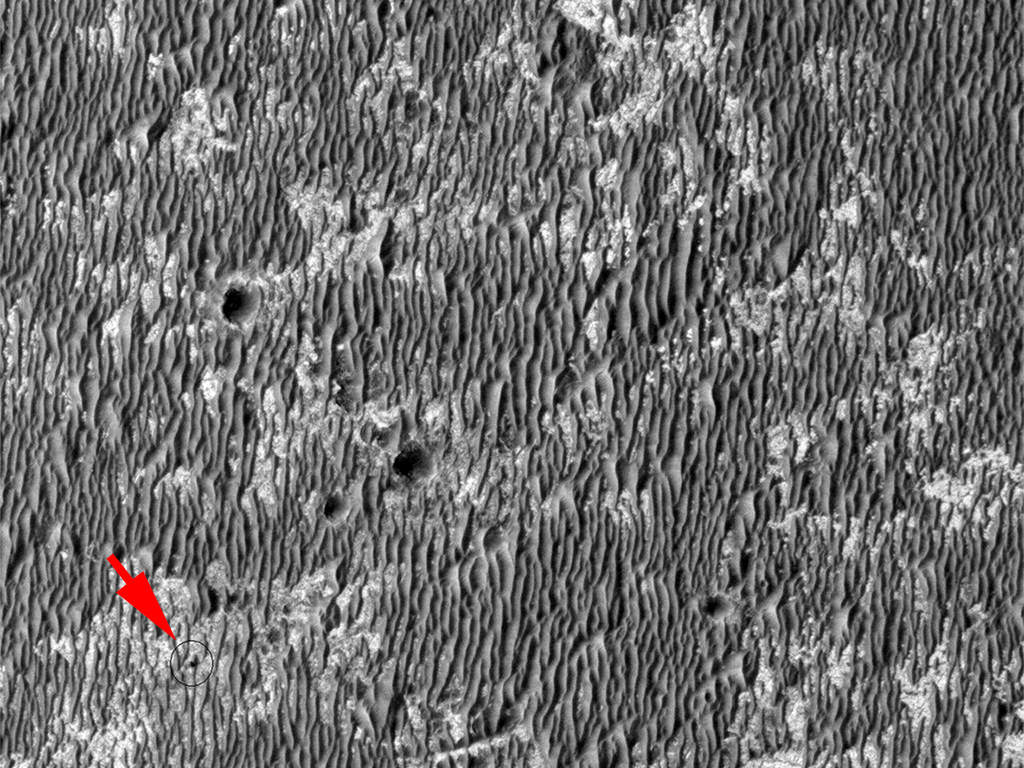[/caption]
Its pictures like these that put the Mars Program into perspective for me. We have two operational rovers that have rolled across the Martian landscape for five years (when they were designed to last only three months), and we have three satellites orbiting Mars carrying out a variety of key scientific studies. For one of the instruments orbiting over 250 km (155 miles) above the Red Planet on board the Mars Reconnaissance Orbiter (MRO), it is fulfilling the “reconnaissance” duties of the MRO rather nicely. The High Resolution Imaging Science Experiment (HiRISE) is helping out its roving buddy, Opportunity, to plot the best route through the undulating sandy dunes of Meridiani Planum. Robots helping other robots on Mars…
We’ve seen shots like this before taken by the high resolution camera used by HiRISE. From spotting the Phoenix Mars Lander repeatedly throughout 2008 to keeping a watchful eye on the progress of both rovers, the instrument has been an invaluable tool for NASA scientists to see what the landscape is like around the tough wheeled robots.
As another sol rolls on, MER Opportunity clocks up some more distance on its epic two year journey toward Endeavour, a crater 20 times larger than Opportunity’s previous crater subject, Victoria (now a feature shrinking in the rover’s rear view mirror). The rover has a long way to go, but should Opportunity survive the trip, it will be a momentous achievement. After all, the rover will be seven years old at that point.

So Opportunity roves on toward the southeast target of the Endeavour crater, about 17 km away. But HiRISE will be watching…
Source: HiRISE


They joined that “Robots Helping Robots” support group when they were doing training at NASA. Usually it just means that robots buy each other drinks and vent about their managers on Friday evenings, but now, in the middle of the mission, that camaraderie is really paying off!
Here’s a dumb question – what doesn’t the sand from all those dunes fill in the craters that are all around? Does anyone have a paper to reference that explains this?
TD…
The craters are very large. Filling them will take a very long time. However, the dirt which gets blown into the crater to fill it up tends to blow right back out, since there is no vegitation to hold it in, and no water to errode the crater.
Think of Meteor Crater near Flagstaff, Arizona. This crater was formed around 50,000 years ago and hasn’t been filled in. Shockingly, this is considered a rather small crater.
Compare this crater with other Earth craters, and consider the environment they are in, allowing them to “heal” so to speak, due to vegitation, water, etcc.
“Sand dune” may be a misnomer actually? Maybe something more like “Dust dune” would be more appropriate?
That is to say, the sand dunes I’m familiar with contain particles that are much larger and more cohesive than what has been found on Mars. Spirit AND Opportunity have occaisionally been trapped in these so-called “Sand dunes” which seem to have an almost a fluid-like quality, perhaps due to being much smaller particles and less compacted in the lower gravity on Mars than what is found on Earth.
With no liquid water (atlest not on the surface) to bind the dust, the dust itself is bound to grind itself into even smaller dust and so on. That is probably why the dust on mars is so much finer than the sand of earthly deserts.